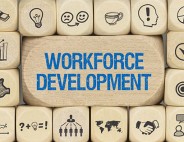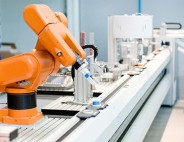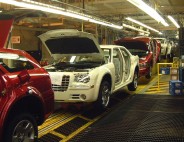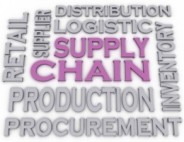
Manufacturing: Welcome Back to the USA
30 May, 2013
By Mark Kleszczewski
Reshoring operations gains traction. Will the trend last?
Despite the lingering effects of the economic downturn and current decline in global demand, new signs of life are appearing in a recovering U.S. industrial base. What seems to be a cyclical upswing in some manufacturing sectors is also being marked by the fairly recent phenomenon of “reshoring” jobs back to North America.
After three years of a slow yet continual rebound, direct manufacturing employment in the United States now stands at just under 12 million workers, a gain of about 500,000 jobs from the overall sector’s lowest point reached in Q1 2010. Of that gain, the Illinois-based Reshoring Initiative estimates that about 50,000 manufacturing jobs have been reshored in the last three years.
“Everyone is talking about reshoring and the increased attractiveness of the U.S. market,” says Chad Moutray, chief economist, National Association of Manufacturers (NAM). “Part of the game changer for American manufacturers is that whereas as recently as a few years ago the United States would not have been one of the more attractive locations to put up a facility, the country is now looked at as a viable option.”
Though the shift remains modest and has yet to make a major dent in stubborn unemployment rates, the return of production back home is encouraging. On the consumer and retail side, big-name companies like Walmart Stores have garnered headlines by committing to carrying additional American-made products over the next decade, while Apple plans to move some of its production back to the United States. Large-scale producers such as NCR, Cummins, John Deere, General Electric, Ford, Electrolux and others have already begun repatriating some of their production, while smaller manufacturers and suppliers are also taking a new look at producing domestically.
“Eventually the U.S. must balance its trade deficit in manufactured goods,” says Harry Moser, founder and president, Reshoring Initiative. “It’s a work in progress, but it’s gotten a lot of momentum and visibility lately, most notably due to rising foreign wages and the recognition of the importance of looking at all the costs, including risks to intellectual property. When it comes to predictability and risk, the rule of law works very well here for both domestic and foreign companies.”
Sectors already showing particular signs of progress in the reshoring trend, Moutray explains, include those involved in energy, metals, steel and chemicals and plastics which rely on natural gas as a feedstock. Research from Boston Consulting Group identified several additional high-value “tipping point” industries as primed for reshoring if favorable conditions continue: computers and electronics, appliances and electrical equipment, machinery, furniture, plastics and rubber, fabricated metals and transportation goods.
Higher transportation and foreign labor costs are not alone in prompting companies to leave China and the Pacific Rim. Other positive forces supporting the case for reshoring are: shifting currency values, increased domestic productivity, clustering near R&D centers to enhance product innovation, plunging domestic natural gas prices and growing consumer preference for American-made goods. Manufacturers and retailers have also begun a wholesale reevaluation of their supply chain vulnerabilities — especially after the 2011 tsunami in Japan and flooding in Thailand.
“We also can’t underestimate the fact that American manufacturers have become much leaner since the worst of the recession, though they were already moving in that direction before then,” Moutray says. “Tremendous productivity gains have been keeping manufacturers a lot more competitive in the United States.”
Sectors already showing particular signs of progress in the reshoring trend, Moutray explains, include those involved in energy, metals, steel and chemicals and plastics which rely on natural gas as a feedstock. Research from Boston Consulting Group identified several additional high-value “tipping point” industries as primed for reshoring if favorable conditions continue: computers and electronics, appliances and electrical equipment, machinery, furniture, plastics and rubber, fabricated metals and transportation goods.
Creating Competitiveness
Indeed, one of reshoring’s main drivers is improved U.S. competitiveness, especially on the “total cost” side of the equation. In a 2010 comparison of the external cost burden of U.S. manufacturers when compared with nine major industrial countries, the Manufacturers Alliance for Productivity and Innovation (MAPI) found that the domestic cost burden had been reduced from 31.7 percent of production costs to 17.6 percent. In fact, Boston Consulting Group expects net labor costs for manufacturing in China and the United States to converge by around 2015.
Given these conditions, one of the keys to a successful reshoring decision is for companies to undertake a comprehensive total cost of ownership (TCO) analysis that calculates the true costs of offshoring, Moser says. To help, his organization provides a free TCO Estimator software tool and an extensive library of reshoring articles and case studies where companies can review real cases of reshoring and associated costs.
This approach also works for communities and EDO’s looking to catch the reshoring wave, Moser points out. Instead of trying to simply attract large-scale OEM’s to an area, it can be faster and more effective convincing OEM’s to source components locally.
He also suggests actively identifying the companies that are either thinking of offshoring or foreign manufacturers exploring local direct investments and getting them to think not in terms of wage rates or an ex-works price, but in terms of total cost and the advantages of producing near their customers. “Once you can demonstrate the total costs companies face, you don’t have to use as many incentives to bring or keep them home,” he says.
Quality Markets, Quality Products
As boosting or moving production closer to home becomes a more realistic option, companies choosing locations are going to look at the quality of the workforce very closely, Moutray notes. That’s why some of the biggest advantages states and localities can provide are strong educational institutions and the ability to attract and retain quality workers.
“Although Florida is not known as a manufacturing state, Tampa Bay has got a significant and growing concentration of manufacturers, especially in high-tech electronics, defense contracting and medical devices,” says Stuart Rogel, president and CEO, Tampa Bay Partnership. “Manufacturers are locating here not only due to our skilled workforce and educational institutions, but also because they’re conveniently located to serve international markets, particularly Central and South America.
Given today’s global economy, time will tell how truly sustainable the resurgence in domestic production will be. For some manufacturers, reshoring may never be a solution for long-term growth. For others, “nearshoring” to Mexico offers a more suitable strategy. Stagnation in the overall economy, budget cuts, overregulation, higher relative corporate taxes and a rising U.S. dollar remain possible drags on reshoring’s momentum.
“Unfortunately, some industries — like boatbuilding — are probably never coming back,” Rogel continues. “But I think we’re seeing that companies are either bringing back manufacturing jobs to our region or they’ve never left, particularly in higher-value and precision manufacturing sectors where quality is really important. Manufacturers are also realizing that getting closer to their customers makes a lot of sense, especially as the costs of making and moving goods overseas goes up.”
Some regions have been leveraging existing strengths and making new investments to further enhance their economies and attract jobs back to local communities.
“While most of the world waited for the economy to rebound, Tennessee and Gallatin were very hard at work — knowing they need to invest in themselves before anyone else will,” says James Fenton, executive director, Gallatin (Tenn.) Economic Development Agency. “We’ve got nearly $100 million worth of infrastructure projects recently completed or underway, backed by already favorable tax conditions, low TVA power rates, initiatives like Partnership 2020 and the Gallatin Expansion and Retention (GEAR) program.”
“The outlook here for 2013 is stronger than 2012 as prospect activity has increased significantly. A number of existing companies have indicated that major expansions are on the horizon particularly in the automotive and food processing sectors,” says Alan Bridwell, executive director, Northeast Tennessee Valley Regional Industrial Development Association. “We continue to emphasize to our existing companies the availability of affordably-priced buildings and the logistical advantages of producing in the same market you are shipping to, especially where on-time delivery of products is crucial. Firms expressing frustration with overseas quality and workforce issues are evaluating the merits of moving jobs back to the U.S.”
For instance, Team Technologies Inc., a contract manufacturer of branded dental products, recently announced that 220 jobs will be brought back from China, while Mullican Flooring, a major high-quality hardwood flooring manufacturer, decided in late 2011 to expand its manufacturing operations to a $13 million facility in Johnson City, replacing part of the company’s production capacity that was coming from Asia.
Working Smarter Pays Off
Given today’s global economy, time will tell how truly sustainable the resurgence in domestic production will be. For some manufacturers, reshoring may never be a solution for long-term growth. For others, “nearshoring” to Mexico offers a more suitable strategy. Stagnation in the overall economy, budget cuts, overregulation, higher relative corporate taxes and a rising U.S. dollar remain possible drags on reshoring’s momentum. Yet those factors are being counteracted by abundant energy options, relentless improvements in operations and adoption of next-generation manufacturing systems which can help attract new opportunities and markets.
“We need to take a serious look at tax and tort reform and other issues going forward, but the phenomenon of low-cost energy is going to continue to accelerate throughout the course of this decade,” Moutray notes. “Between that and other advantages that have taken hold, the U.S. should be an attractive place in the years ahead.”
“Our region went through significant company downsizing during the recession, but today we’re seeing growth and rehiring above the national average,” Rogel says. “I think a lot of manufacturers have taken the opportunity to reinvest and become more efficient and productive. It can be frustrating during the downturn, but having our local industries and companies become more viable and competitive entities should ultimately lead to more jobs coming back.”
For complete details on the organizations featured in this article, visit:
Gallatin (Tenn.) Economic Development Agency
National Association of Manufacturers
Northeast Tennessee Valley Regional Industrial Development Association
Ajax, Ont.: Where Businesses Come First
Manufacturing companies looking to return operations or product developments to North America would benefit from locating to the town of Ajax, Ont. The town’s companies have fared well since 2008, when many areas experienced attrition with companies closing operations or outsourcing functions offshore. “I attribute this to the fact that the companies are small and nimble, so they could keep their doors open, as well as expand,” says Andrew Poray, senior business development and marketing coordinator, town of Ajax, located in the Toronto metro.
Poray says manufacturing activities are also returning to Ajax from offshore locations. For example, a textile manufacturing in his community, one of only two left in Ontario, was experiencing difficulties in regard to specialized runs and turning around products in a compressed timeline. “They found out very quickly that China wasn’t the answer,” Poray says. “If they wanted to address those needs the activities needed to be in house. And we are starting to see some of that manufacturing come back and expand into the Ajax market.”
The manufacturing cluster in Ajax includes skill sets serving auto suppliers, aero suppliers, packaging and environmental products manufacturing companies, among others.
In regard to business friendliness, the town of Ajax was Canada’s first community to be designed as a Competitive Ready Community by the CR Group, which gives site selectors a “green light” to move forward with projects, as more than 175 factors are audited, which fall into 10 categories.
Ajax also offers Priority Path, an expedited planning approvals program. “We let them know the expectations, help them to overcome any potential planning roadblocks, and make things as quick and easy as possible,” Poray says.
For more information, visit www.ajaxfirstforbusiness.ca.
Chatham-Kent: Business Beyond Borders
Located in the heart of southwestern Ontario just minutes from the Windsor/Detroit border, Chatham-Kent’s easy access to Highway 401 and proximity to three major border crossings coupled with competitive land costs have made the community a popular location for business. Attracting new manufacturers to vacant industrial buildings and assisting others to access funds allowing them to expand, helped Chatham-Kent rebound significantly from the pre-2009 contractions that were felt globally, explains Stuart McFadden, manager, business development, Chatham-Kent (Ontario) Economic Development Services.
Companies like Cross Country Trailer, Lambton Conveyor Ltd., Truly Green, Edge EDM, Sharkskin, Siemens, GDF Suez and Krinner, have all decided to invest in the municipality over the last year thanks in part to an available, experienced talent pool and affordable land and buildings, he says.
The area’s skilled workforce, location covering both Canadian and U.S. markets, low business operating costs and an aggressive FDI strategy for Asia all support the local manufacturing sector whose areas of focus are shifting to include agri-business, food processing and bioproducts. Recently a 90 plus acre multi-million-dollar greenhouse project, the first of its kind in Canada, broke ground in Chatham-Kent.
Transportation costs are forcing every company to rethink where their products or services originate, McFadden notes. Costs are rising in some of the foreign countries that benefitted from off-shoring originally but the playing field is becoming more even. “Local companies are benefiting from this reality and we expect others will in the future as well,” he says.
To learn more, visit www.chatham-kent.ca/EconomicDevelopment.
Illustration by Stuart Miles at Free Digital Photos.net
Related Posts
-

Development in Transition
-

Advanced MFG
-

Advanced Manufacturing Now in Every Industry Sector
-

Manufacturing Combats Workforce Uncertainties
-

Auto Suppliers: Under Pressure
-

Reshoring Essential to Manufacturing’s Renaissance
-

Manufacturing: Growth and Reshoring Shape 2015
-

Manufacturers Take Sustainability to New Levels
-

What does Manufacturing Mean to You? Video
-

Building the Future of Manufacturing










